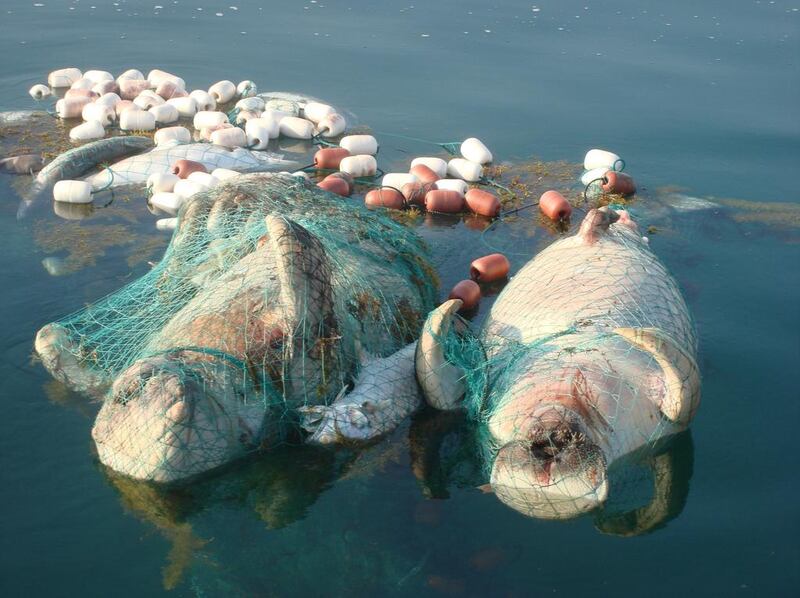ABU DHABI // Fishing nets are the leading cause of dugong deaths in Abu Dhabi’s coastal waters, scientists have said.
Since 2000, the Environment Agency Abu Dhabi (EAD) has investigated 153 dugong deaths.
Of these, 111, or 72.5 per cent, were caused by drowning after the mammal was caught up in nets.
If data from the past five years is reviewed, fishing nets contributed to 85 per cent of deaths.
The creatures feed on sea grass and are protected under federal law, meaning targeting them directly or unintentionally can lead to heavy fines.
While EAD scientists have no doubt the data is reliable when it comes to highlighting the main threat to Abu Dhabi’s population of the endangered animals, the numbers could in reality be higher.
“Globally, usually 50 to 60 per cent of marine mammal mortality incidents are reported,” said Dr Himansu Das, unit head for marine threatened species and habitats at EAD’s terrestrial and marine biodiversity sector.
While it is not possible to record all deaths, it is clear that “the rate of dugongs dying in fishing nets has increased”, he said.
“That means, in the past five years, the fishing effort has increased, or the use of illegal fishing nets [has increased],” said Dr Das.
Most of the fatalities were reported between November and March when increased numbers of dugongs congregate off the shallow coastal waters of Abu Dhabi and when there is also heightened fishing activity.
A type of drift net, known as hiyali, was identified by the EAD as the cause of the deaths.
These nets, which reach in length from 500 metres to a kilometre, are used illegally by fishermen to catch king fish.
They are deployed at locations with a maximum depth of 10 metres and left to drift. Fishermen return to collect nets based on calculations about currents.
The estimates are often wrong and the nets are lost, posing a risk to marine wildlife.
As they have poor eyesight, dugongs are very vulnerable, said Dr Das.
EAD has conducted informal interviews with fishermen as part of its study and found that the majority were aware of the laws prohibiting the use of illegal nets and the protected status of dugongs.
Yet many continue to rely on this lucrative method of fishing, the agency said.
Last year, EAD carried out workshops in the Western Region and is planning on continuing its efforts to ensure existing fishing regulations are implemented, as well as necessary marine clean-ups, Dr Das said.
The agency is also planning to increase aerial surveys outside marine protected areas where the dugong population is “very healthy,” said Dr Das.
“Most of this mortality happens outside protected areas,” said Dr Das, who explained that 20 per cent of aerial monitoring was in waters with no special protection status.
The UAE is one of 26 signatories of a United Nations-backed global programme to conserve dugongs in the 40 states where they live.
Dr Donna Kwan, the initiative’s programme officer, said that human-related activities, particularly use of fishing gear, were the main cause of dugong deaths around the world.
“The UAE is the only country other than Australia that has historical datasets relating to mortality,” she said.
“The UAE has all the right tools in place.
“The question is why, despite these measures, dugong mortality continues?”
The National approached the Abu Dhabi Fishermen Cooperative Society but was unable to obtain comments.
vtodorova@thenational.ae





